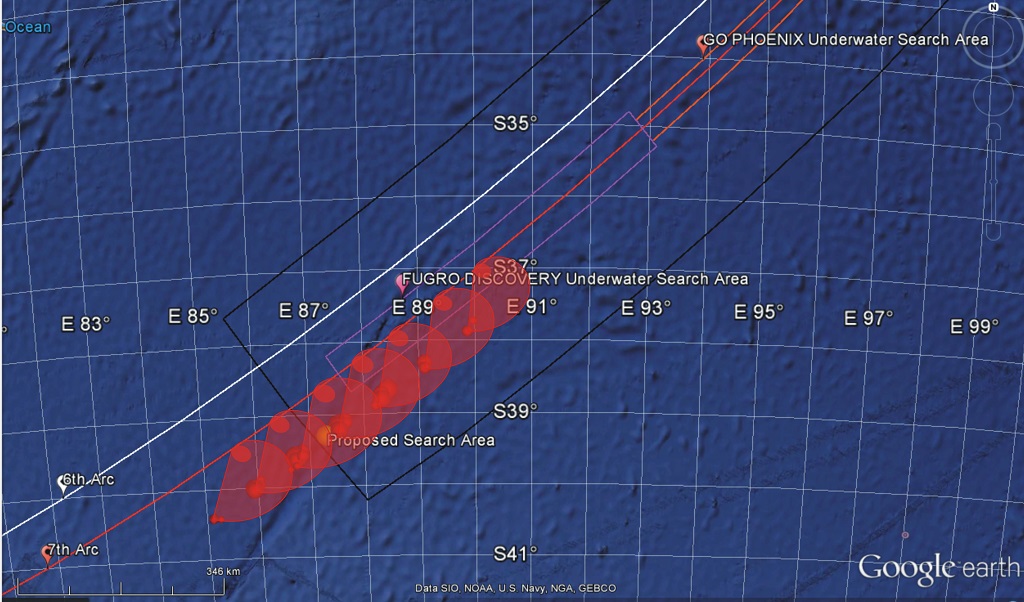Octavian Thor Pleter and Cristian Emil Constantinescu, and Barna Istvan Jakab, University Politehnica of Bucharest, 060042 Bucharest, Romania
Abstract: In the aftermath of the disappearance of the Malaysian 370 (MH370) flight in March 2014, new positioning methods were employed to establish the search area. In the absence of all other positioning technologies (Transponder, Radio communications, Radar), these innovative methods are based on the handshake signals between an INMARSAT satellite and the satellite transceiver on board the aircraft. The log of these signals was made public in order for the scientific community to engage in solving the mystery of the MH370 trajectory. The log indicates the delay between the interrogation and response signals, as well as the relative velocity indications, based on the shift of the carrier frequency due to the Doppler-Fizeau effect. This paper puts forward an original, independent and accurate positioning method and allows the calculation of the MH370 trajectory considering the wind vector field that day, the accurate satellite orbit and an accurate model of the Earth (the WGS-84 ellipsoid). The results were compared to other results published, indicating a different final position of the aircraft from the locations of the published search area.
Download full article here.
The article won the Richey Medal 2017 of the Royal Institute of Navigation, London.
MS Regele Mihai
The academic community of the Faculty of Aerospace Engineering is in pain and deep sorrow for the loss of HM King Michael I of Romania (1921-2017). The King was a passionate of technology, especially of aviation. Some pictures that we found illustrate this...
European Space Generation Workshop
Following Budapest and Paris, the 3rd edition of the European Space Generation Workshop, gathering young professionals and students working in the space sector, is set to take place in Bucharest, Romania on the 9th and 10th March 2018. The two-day regional...
Traian Vuia (en)
Traian Vuia, was a Romanian aeronautical pioneer, from Surducul-Mic, then a small village in the Austro-Hungarian Empire. Being scientifically minded, he attended the School of Mechanics at the Polytechnic University in Budapest. Due to a lack of money, soon he...
Traian Vuia Story
Traian Vuia Traian Vuia (also known as Trajan Vuia) was a Romanian inventor and pioneer in the aviation field. He is credited with the achievement of successfully building, thus demonstrating, that a flying apparatus could rise into the air using only its...
Traian Vuia Story
Traian Vuia Traian Vuia (also known as Trajan Vuia) was a Romanian inventor and pioneer in the aviation field. He is credited with the achievement of successfully building, thus demonstrating, that a flying apparatus could rise into the air using only its engine and...
IAR American
On 18 November 2017 in the Acad. Virgiliu Constantinescu amphitheater, professors and students of the Faculty of Aerospace Engineering met Eng. Pilot Gabriel Iancic, President of the IAR AMERICAN organization and Eng. Sorin Ploscaru, aircraft designer. IAR...
George Constantinescu
George Constantinescu
Wanted ATC / ATM Software Engineer
C# and C++ Air traffic control ATC / ATM Software Engineer (BBBH340) Bournemouth, England Salary: GBP38 - GBP39 per hour C# Software Engineer - Air Traffic Control Systems Key skills: C# , C++ , Software Engineer - Air traffic Management C# C++ Software...
Openings at Smart Airline Services
S.C. SMART AIRLINE SERVICES SRL is hiring graduates or senior year students in the field of air cargo transport . candidates should send their CV at: dragos.stefanescu@smart-airline.ro Smart Airline Services are a member of Global GSA Group B.V. with the main...
Smaranda Brăescu
Where and When Smaranda Brăescu was born? She was born in the village of Hânţeşti, Buciumeni commune, in the present-day Galați County. It is very vague, many say on May 21, 1897, but as an example, on her student grades book it is mentioned May 23, 1904. We...


0 Comments